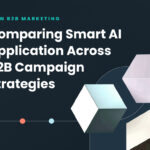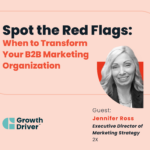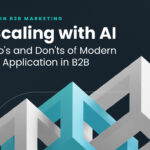Unlike traditional lead generation, which often focuses on collecting as many contacts as possible, Demand Generation is about creating and capturing demand in a way that drives real revenue impact. Done right, it aligns marketing, sales, and revenue teams to attract, engage, and convert high-value prospects; not just fill the pipeline with names.
So when does your B2B business need a Demand Gen strategy? And what do you need to execute it effectively? Let’s break it down.
What Is Demand Generation?
It’s a scalable approach to creating, capturing, and converting demand. Unlike lead generation, which focuses on filling short-term pipeline, Demand Generation is about:
- Building brand awareness that makes buyers seek you out
- Educating the market and guiding high-value prospects toward your solution
- Driving revenue, not just leads, by aligning marketing with sales goals
It’s long-term and strategic—designed to attract the right buyers and move them from interest to action.
When Do You Need Demand Gen?
You don’t need it if leads are converting, deals are closing, and sales and marketing are aligned. But if any of the below apply, it’s time to act:
- Sales says the leads are weak. If your team is generating MQLs that don’t convert, Demand Gen helps attract high-intent buyers who are actually ready to engage.
- You’re too dependent on outbound or paid ads. If marketing is constantly chasing prospects instead of creating inbound demand, you need a Demand Gen strategy to build authority and trust.
- Sales cycles are too long, or deals stall out. If you have leads but they aren’t moving, Demand Gen nurtures and educates buyers so they’re ready to take action faster.
- Your competitors own the conversation. If your audience isn’t engaging with your brand, they’re engaging with someone else. Demand Gen builds thought leadership and keeps your brand top-of-mind.
- Marketing and sales aren’t aligned. If marketing is focused on lead volume while sales needs sales-ready leads, Demand Gen bridges that gap.
What You Need to Make Demand Generation Work
B2B Demand Generation isn’t just a campaign; it’s a business function. Here’s what you need:
- A Clear ICP and Buyer Journey. Your Ideal Customer Profile (ICP) and buyer journey need to be mapped out so marketing efforts reach the right audience at the right time with the right message.
- Content That Converts. Your content needs to meet buyers where they are:
- Top-of-Funnel (TOFU): Thought leadership, brand awareness content, etc
- Middle-of-Funnel (MOFU): Case studies, webinars, solution-based content
- Bottom-of-Funnel (BOFU): Competitive comparisons, sales enablement
- Multi-Channel Distribution. Demand Gen works because it engages prospects across multiple touchpoints:
- Paid and organic social
- Email and nurtures
- SEO and content marketing
- ABM and targeted ads
- Sales and Marketing Alignment. Marketing and sales need to speak the same language and agree on:
- What defines a high-intent lead
- How leads will be nurtured and handed off
- Revenue-driven KPIs, not just MQLs
- The Right Martech Stack. Technology supports Demand Gen, but only if it’s used effectively. Your stack should include:
- Marketing Automation (Hubspot, Marketo) – For lead nurturing and scoring
- CRM (Salesforce, HubSpot CRM) – For tracking pipeline movement
- Intent Data (6sense, Demandbase) – To identify in-market buyers
- Ad Platforms (Linkedin Ads, Google Ads) – To capture and expand demand
Demand Gen Is a Growth Engine—Not a Tactic
If you’re ready to move beyond traditional lead gen and build a system that fuels long-term growth, it’s time to invest in Demand Gen.
Want to see how leading companies execute Demand Gen at scale? Let’s talk!




